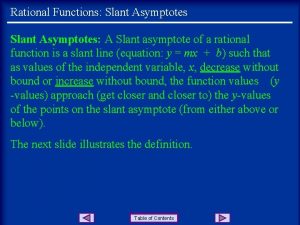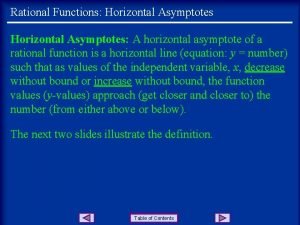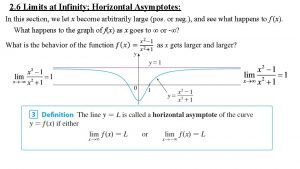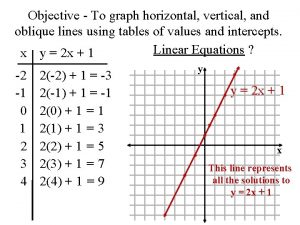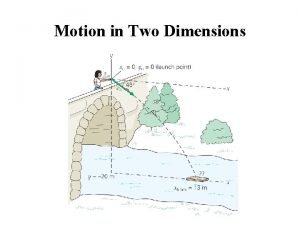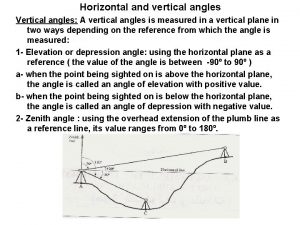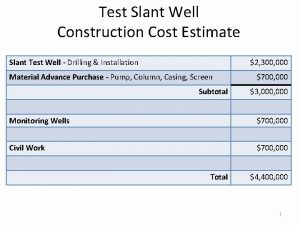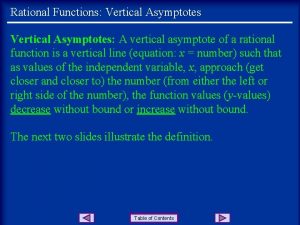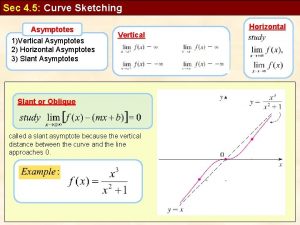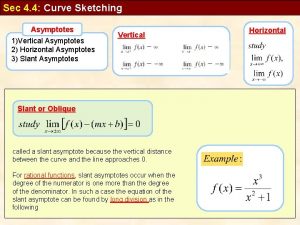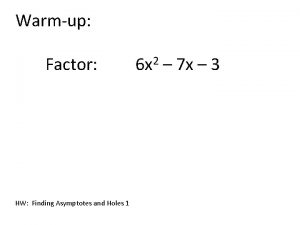ASYMPTOTES TUTORIAL Horizontal Vertical Slant and Holes Definition






























- Slides: 30

ASYMPTOTES TUTORIAL Horizontal Vertical Slant and Holes

Definition of an asymptote l An asymptote is a straight line which acts as a boundary for the graph of a function. l When a function has an asymptote (and not all functions have them) the function gets closer and closer to the asymptote as the input value to the function approaches either a specific value a or positive or negative infinity. l The functions most likely to have asymptotes are rational functions

Vertical Asymptotes Vertical asymptotes occur when the following condition is met: The denominator of the simplified rational function is equal to 0. Remember, the simplified rational function has cancelled any factors common to both the numerator and denominator.

Finding Vertical Asymptotes Example 1 Given the function The first step is to cancel any factors common to both numerator and denominator. In this case there are none. The second step is to see where the denominator of the simplified function equals 0.

Finding Vertical Asymptotes Example 1 Con’t. The vertical line x = -1 is the only vertical asymptote for the function. As the input value x to this function gets closer and closer to -1 the function itself looks and acts more and more like the vertical line x = -1.

Graph of Example 1 The vertical dotted line at x = – 1 is the vertical asymptote.

Finding Vertical Asymptotes Example 2 If First simplify the function. Factor both numerator and denominator and cancel any common factors.

Finding Vertical Asymptotes Example 2 Con’t. The asymptote(s) occur where the simplified denominator equals 0. The vertical line x=3 is the only vertical asymptote for this function. As the input value x to this function gets closer and closer to 3 the function itself looks more and more like the vertical line x=3.

Graph of Example 2 The vertical dotted line at x = 3 is the vertical asymptote

Finding Vertical Asymptotes Example 3 If Factor both the numerator and denominator and cancel any common factors. In this case there are no common factors to cancel.

Finding Vertical Asymptotes Example 3 Con’t. The denominator equals zero whenever either or This function has two vertical asymptotes, one at x = -2 and the other at x = 3

Graph of Example 3 The two vertical dotted lines at x = -2 and x = 3 are the vertical asymptotes

Horizontal Asymptotes Horizontal asymptotes occur when either one of the following conditions is met (you should notice that both conditions cannot be true for the same function). The degree of the numerator is less than the degree of the denominator. In this case the asymptote is the horizontal line y = 0. The degree of the numerator is equal to the degree of the denominator. In this case the asymptote is the horizontal line y = a/b where a is the leading coefficient in the numerator and b is the leading coefficient in the denominator. When the degree of the numerator is greater than the degree of the denominator there is no horizontal asymptote

Finding Horizontal Asymptotes Example 4 If then there is a horizontal asymptote at the line y=0 because the degree of the numerator (2) is less than the degree of the denominator (3). This means that as x gets larger and larger in both the positive and negative directions (x → ∞ and x → -∞) the function itself looks more and more like the horizontal line y = 0

Graph of Example 4 The horizontal line y = 0 is the horizontal asymptote.

Finding Horizontal Asymptotes Example 5 If then because the degree of the numerator (2) is equal to the degree of the denominator (2) there is a horizontal asymptote at the line y=6/5. Note, 6 is the leading coefficient of the numerator and 5 is the leading coefficient of the denominator. As x→∞ and as x→-∞ g(x) looks more and more like the line y=6/5

Graph of Example 5 The horizontal dotted line at y = 6/5 is the horizontal asymptote.

Finding Horizontal Asymptotes Example 6 If There are no horizontal asymptotes because the degree of the numerator is greater than the degree of the denominator.

Graph of Example 6

Slant Asymptotes l Slant asymptotes occur when the degree of the numerator is exactly one bigger than the degree of the denominator. In this case a slanted line (not horizontal and not vertical) is the function’s asymptote. l To find the equation of the asymptote we need to use long division – dividing the numerator by the denominator.

Finding a Slant Asymptote Example 7 l If l There will be a slant asymptote because the degree of the numerator (3) is one bigger than the degree of the denominator (2). l Using long division, divide the numerator by the denominator.

Finding a Slant Asymptote Example 7 Con’t.

Finding a Slant Asymptote Example 7 Con’t. We can ignore the remainder The answer we are looking for is the quotient and the equation of the slant asymptote is

Graph of Example 7 The slanted line y = x + 3 is the slant asymptote

Holes l Holes occur in the graph of a rational function whenever the numerator and denominator have common factors. The holes occur at the x value(s) that make the common factors equal to 0. l The hole is known as a removable singularity or a removable discontinuity. l When you graph the function on your calculator you won’t be able to see the hole but the function is still discontinuous (has a break or jump).

Finding a Hole Example 8 Remember the function We were able to cancel the (x + 3) in the numerator and denominator before finding the vertical asymptote. Because (x + 3) is a common factor there will be a hole at the point where

Graph of Example 8 Notice there is a hole in the graph at the point where x = -3. You would not be able to see this hole if you graphed the curve on your calculator (but it’s there just the same. )

Finding a Hole Example 9 l If l Factor both numerator and denominator to see if there any common factors. l Because there is a common factor of x - 2 there will be a hole at x = 2. This means the function is undefined at x = 2. For every other x value the function looks like

Graph of Example 9 There is a hole in the curve at the point where x = 2. This curve also has a vertical asymptote at x = -2 and a slant asymptote y = x.

Problems Find the vertical asymptotes, horizontal asymptotes, slant asymptotes and holes for each of the following functions. (Click mouse to see answers. ) Vertical: Horizontal : Slant: Hole: x = -2 y=1 none at x = - 5 Vertical: Horizontal : Slant: Hole: x=3 none y = 2 x +11 none
 Horizontal asymptotes
Horizontal asymptotes Vertical asymptote
Vertical asymptote Limits at infinity (horizontal asymptotes)
Limits at infinity (horizontal asymptotes) Rational functions holes and asymptotes
Rational functions holes and asymptotes How to find slant asymptotes
How to find slant asymptotes Horizontal asymptote conditions
Horizontal asymptote conditions Steps for graphing rational functions
Steps for graphing rational functions Xaxxx
Xaxxx How to determine slant asymptotes
How to determine slant asymptotes Slant asymptotes
Slant asymptotes Asymptote rules
Asymptote rules Horizontal asymptote equation
Horizontal asymptote equation Irrational parent function
Irrational parent function Vertical asymptote
Vertical asymptote How to find horizontal asymptotes
How to find horizontal asymptotes Limits at infinity definition
Limits at infinity definition Horizontal asymptote
Horizontal asymptote Limits at infinity definition
Limits at infinity definition Horizontal asymptote rules
Horizontal asymptote rules Sketching asymptotes
Sketching asymptotes Harlem poem
Harlem poem Vertical deflection system
Vertical deflection system Horizontal multilingualism
Horizontal multilingualism What is a real covenant
What is a real covenant Wave patterns take attention away from the face
Wave patterns take attention away from the face Is the vertical and horizontal configuration of departments
Is the vertical and horizontal configuration of departments Random scan vs raster scan
Random scan vs raster scan Vertical horizontal x y
Vertical horizontal x y Projectile motion displacement formula
Projectile motion displacement formula Vector components
Vector components Vertical angles
Vertical angles









